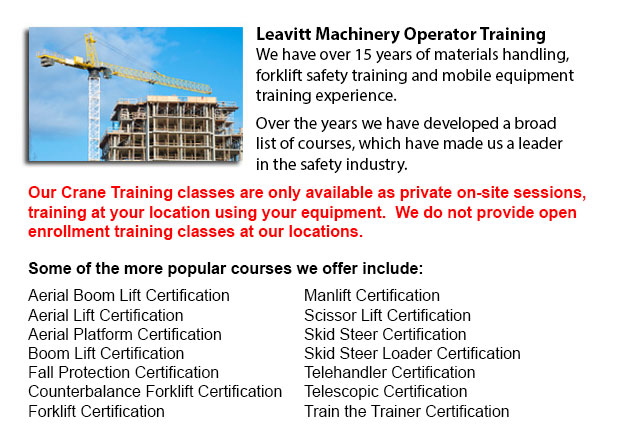
Nanaimo Overhead Crane Safety Training - Overhead crane safety training equips operators with knowledge and skills about crane safety precautions, accident avoidance, materials handling, and equipment and stock protection. Trainees would learn the kinds of overhead cranes, their capabilities and their uses in various industry settings. For operators who are trained and licensed, the shift in liability moves from the company to the operator. Thus, the program emphasizes individual operator tasks.
The operators in the overhead safety training course will be given instruction about the right techniques for doing inspections: the pre-shift inspection and the more detailed in-depth inspection. These are vital every day routines that must be logged. Properly recorded pre-shift inspections help to protect the business from liability in case of an accident. Pre-shift checks likewise prevent accidents, damage and costly repairs. Operators learn how to designate a particular person to carry out inspections, how to report problems, and how to maintain the log book.
Inspections must be performed often and documented properly. The following should inspected while watching for common problems: hooks for cracks, increases in the throat opening, degree of twist; hoist ropes for corrosion, worn wires, loss of diameter, broken wires, kinks and bird caging, heat and chemical damage; chains for gouges and nicks, twists, corrosion and cracks, distortion, excessive wear, stretching, pits, damage from extreme heat.
Operators learn correct rigging procedures in this program. Rigging involves understanding the manufacturer's data plate, determining the weight of materials to be lifted, choosing the gear, and using safe practices to secure the load. The program include in detail the following: safe working loads, and the capacities of ropes, chains, hooks, shackles and slings.
It is essential to know who may utilize the cranes at your facility, the job's physical requirements, and operator credentials needed for permits and specialized job. Safety should be prioritized when using near pedestrian traffic.
The responsibilities involved in the safe crane utilization consists of checking for hydraulic leaks, undertaking visual inspections, testing the controls, checking the safety guards, examining the hoist rope and hook, braking mechanisms and limit switches. Right reporting methods are important. These subject matters are all covered in depth in the course.
The course also includes the proper moving and lifting procedures with cranes and hoists. Operators will also learn proper hand signals. Training involves how to raise the load, attach the load, unhook the slings, abort a lift and set the load.
Moving the load involves several steps: stopping and starting procedures, guiding and controlling the load, observing working conditions and working with signals. Operators should know how to proceed in case of a power failure. The course covers techniques for removing the slings and lowering the load, parking the crane, storage equipment, and securing an indoor and outdoor crane.
-
Nanaimo Boom Lift Certification
Nanaimo Boom Lift Certification - Using elevated work platforms allow for maintenance operations and work to be carried out at elevated work heights which were otherwise not reachable. Workers making use of scissor lifts and boom lifts can learn how... More -
Nanaimo Boom Lift Safety Training
Nanaimo Boom Lift Safey Training - Boom lifts are a kind of aerial lifting device or elevated work platform which are commonly used in industry, warehousing and construction. Boom lifts could be utilized in practically whichever environment because o... More -
Nanaimo Loader Operator Training
Nanaimo Loader Operator Training - Loader Operator Training - Forklift training is a prerequisite within North America and is intended to prevent workplace death and injuries. Lift truck training provides driver training intended for forklift operato... More -
Fall Protection Certification in Nanaimo
There are high numbers of injuries at work associated to falling and lots of fall-related deaths reported each and every year. Most of these instances might have been prevented with better training, better measures in place, and by properly equipping... More -
Nanaimo Crane Ticket
Nanaimo Crane Ticket - The modern version of a crane can be either complex or simple, and cranes vary based on their use. Mobile cranes, for example are rather simple. A telescopic boom or steel truss mounts its movable platform. A system of levers o... More -
Operator Safety Certification | Re-Qualification Certification | In-House Instructor Certification in Nanaimo
Lift trucks are used in practically all industrial construction sites and in warehouse operations and in boat yards. The reach feature of a forklift is a very important part utilized in several applications like when a shelving system is being used t... More -
Aerial Lift / Boom Lift / Man Lift / Scissor Lift Certification in Nanaimo
Scissor hoists are lift tables which lift up materials and individuals and supplies vertically. They are normally used in construction, commercial and industrial environments. A common use of scissor hoists is for lowering or lifting construction sup... More -
Crane / Overhead Crane / Self-Erect Crane / Truck Mounted Crane / Hydraulic Cranes Certification in Nanaimo
Bridge cranes or likewise called overhead cranes are a type of industrial material handling crane utilizing a line and hook apparatus that runs on a horizontal beam running along two widely separated rails. Several overhead cranes can be seen inside... More

Forklift Certification Nanaimo
TOLL FREE: 1-888-254-6157
Nanaimo, British Columbia
forkliftcertificationnanaimo.com
Email Us
About Us


